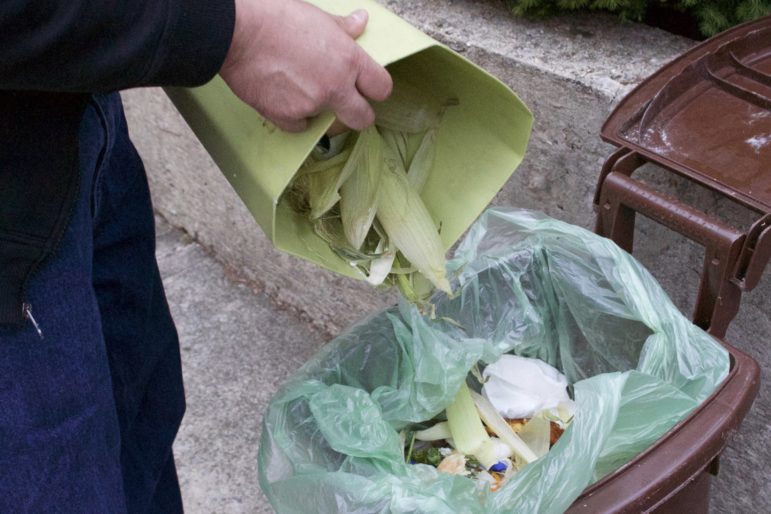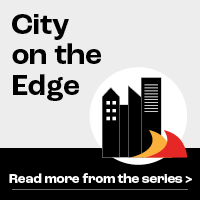The program, which has been on hold since May 2020, kicks off again Monday in four Brooklyn neighborhoods as a budget report notes high costs to sustain it.

City Limits/Manoli Figetakis
After a long hiatus due to the Covid-19 pandemic, New York City’s curbside composting program kicked off again on Monday. But lack of interest in participation, along with associated high costs, is limiting the program to only several communities—including several affluent neighborhoods in Brooklyn—at least at first.
This week, the program will become available to residents of Community Board 6, which includes the neighborhoods of Red Hook, Gowanus, Carroll Gardens and Park Slope, and where the average household income is nearly double the state average. Twice as many residents of the district signed up online for curbside composting as the neighborhoods with the second most interest, Sunset Park and Windsor Terrace, according to the most recently available data from the city’s Department of Sanitation (DSNY).
The department will announce in mid-October which neighborhoods will be selected next for collection to begin in November, according to a DSNY spokesperson. “This is based primarily on concentration of signups in order to minimize the greenhouse gas emissions from collections vehicles,” he said.
Residents in other areas of the city can instead bring their food scraps to dispose of at one of the city’s drop-off points, which are currently open and being added to, according to DSNY. The sites will accept produce, eggshells, coffee and tea, dried flowers and houseplants and grains. (A map of drop-off points and a list of what is and is not accepted is available on the city’s website.)
The curbside composting program has been on hold since May 2020 due to budget cuts and safety concerns around COVID. In announcing the suspension, then-Sanitation Commissioner Kathryn Garcia asked New Yorkers for patience and cooperation.
“These are painful cuts to make, and we do not take these changes lightly,” she said at the time. Five months later, Garcia, who was since appointed director of state services by Gov. Kathy Hochul, resigned from the post and launched her mayoral campaign, citing frustration over the budget restrictions.
In April, Mayor Bill de Blasio announced that DSNY would restart curbside composting this fall. Interested New Yorkers were encouraged to sign up online. But some took issue with how City Hall reinstated the rollout, worrying it could further exacerbate disparities around who has access to the service.
“Setting up a competitive system that forces people to ‘opt-in’ rather than ‘opt-out’ is sure to heighten inequity and disparate treatment,” several Bronx community members wrote in an open letter to DSNY last month. “People who are already comfortable and fortunate are more likely to have been educated about the long-term value of composting, be personally familiar with it, and have the time and energy to spend organizing to get neighbors to opt-in.”
A report released Monday by the city’s Independent Budget Office shows that low interest in curbside composting makes the program both expensive and potentially not environmentally sustainable, since the service requires sanitation trucks to pick up the food waste. But a significant shift to high participation by city residents would decrease the cost and provide environmental benefits that counterbalance the greenhouse gas emissions from increased truck traffic, the report noted.
In 2019, the cost per tonnage to collect and process organic waste was $734, more than three times as expensive as refuse ($216 a ton) and recycling ($206 a ton). Participation in the program has increased each year since 2013, when the city’s Local Law 77 mandated that the city initiate a voluntary organics collection program. But as of 2019, the city still only diverts 1.4 percent of waste from landfills to organics collection, the report notes.
If New Yorkers were to increase that amount of waste diverted to organics collection to 15 percent —the same rate of its recycling collection—the program would cost only slightly more ($39 per ton) than refuse collection, the IBO report found.
In turn, the required additional truck runs would increase carbon dioxide emissions by 2,600 tons a year, the office estimated, noting that the neighborhoods most affected by the increase would be environmental justice neighborhoods where waste transfer facilities receiving the trucks are located. These neighborhoods, including areas of Bronx and Queens, have higher-than-normal asthma rates that have previously been linked to vehicle emissions.
At the same time, a 15 percent diversion of organics away from landfills will save about 250,000 tons of greenhouse gas emissions citywide.
“[Doing so] represents one of the most effective ways for the city to combat climate change by shrinking the quantity of waste sent to landfills,” the report says.
Liz Donovan is a Report for America corps member.










2 thoughts on “Curbside Composting Program Restarts with Low Participation and High Cost”
Composting is still unpopular because homeowners know the bins will stink up their property no matter what the DSNY says. According to the DSNY chart not every sanitation district is on the list. So in some districts it appears that no one showed interest in this overpriced virtue signalling program. I’m not going to stink up my property and my block with this nonsense.
(BTW, the DSNY couldn’t provide an .xlsx file of Composting requests?)
I was so saddened to hear this wouldn’t be returning.I don’t drive,so I don’t think I can keep all my compost and bring it.Was looking forward to it.